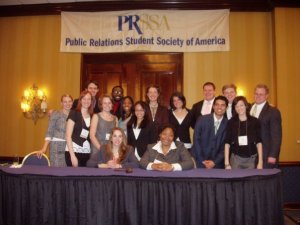-
I. Can't. Wait.
Filed under: Uncategorized
May 29, 2009 • 2:01 pm 0
Filed under: Uncategorized
May 17, 2009 • 5:53 pm 0
Besides moving out of East Lansing and complaining about the whole thing, I’ve been up to some pretty cool things. With classes finished for the semester, I’m starting to get my summer plans in order. Part of this is making the move to Chicago, and this will be my first summer away from East Lansing since I started at Michigan State University. I’ll also be starting an internship with Edelman in their digital group, as well as starting my National PRSSA position. In the interest of being open and transparent, you’ll probably be seeing more about the following:
I just moved out of my house last week. While I’ve lived here, the house has been broken into, we’ve had sewage problems, our kitchen has been remodeled and we had unwanted pets (never figured out what the scratches in the walls were), among other things. Even though the house was literally falling apart, I’m going to miss this place and mostly the front porch.

Recently, I was elected National Vice President of Professional Development by PRSSA at the National Assembly in New Orleans. In that position, I’ll be blogging at the PRSSA Blog, supporting student-run firms across the country and some other pretty cool things. I’ll also be traveling to Scottsdale in June with the other National Committee members to plan for the upcoming year and get things going. Here’s a picture of the 2008-2009 and 2009-2010 National Committees:

Also, I’m going to be moving to Chicago for the summer and interning with Edelman Digital. I’m starting right after Memorial Day and I can’t wait. The team has a blog and I hope you check it out. Below is a picture of where I’ll be for the summer.

So, what’s the future of this blog? Because I’m blogging at a few other places, I probably will only have time for one post per week. I’ve covered a lot of “tips” for PR students, and I hope to discuss issues we’ll be facing and how to addresses them in addition to more posts about the industry. Thanks for reading and I hope you keep up with me.
Filed under: Uncategorized, chicago, east lansing, edelman, edelman digital, msu, PRSSA, prssa national committee
April 2, 2009 • 12:39 am 6
I’ll be the first one to admit I don’t know a lot about investing. I know it’s a good idea to invest when the market is down, and hopefully, I’ll make some money when the market turns around. That’s about it. I’ve been doing some more research lately and hope to start investing one of these days, but I couldn’t help noticing how similar investing in the stock market is to a career.

On thing I’ve learned is that your career is a lot like the stock market, for a lot of reasons. Here are 16 basic principles on investing (in your career) from Swap Meet Dave:
All in all, those are the principles that I’ve held true during my college career. I’ve applied for a ton of positions. Some I’ve earned, and some I didn’t. Even so, I’m able to pick myself up and move on to the next project with ease. Things happen for a reason, and with a proactive and positive attitude, you’ll see the bigger fish in the ocean.
So what do you think? How else is a career like the stock market? How do you invest in your career?
Photo by eminiforecaster on Flickr.
Filed under: Uncategorized
March 5, 2009 • 1:59 am 5
During a recent MSU PRSSA meeting, Kelly Rossman-McKinney, CEO of Rossman PR, came in to talk about how to write a communication plan and important principles to execute the plan. Personally, it was extremely helpful and it served as a reminder that we are in a completely strategic field. Doing something just to do it won’t get you anywhere (for an example, look on Facebook for all the companies who have a Facebook page but don’t do anything with them). The video summary of what she talked about is right here:
Kelly talked about her eight-step approach when it comes to strategic public relations. Whether you are running a political campaign or fundraising for a nonprofit, these principles apply. Better yet, try and create a communication plan within a student group or current place of employment. Here are her steps and strategies:
The eight-step approach to strategic public relations planning:
After you come up with all of these steps and plans for a campaign, it’s important to keep a strategic focus. The next list is a set of questions you should be able to answer clearly and concisely.
Principles of effective communication:
All in all, it was a great meeting and a great presentation. Another online resource I found is from Dave Fleet, who has a great (and free!) e-book on writing a strategic communication plan here.
Any other tips for writing a communication plan? Any resources you’d like to share?
Filed under: Professional Development, PRSSA, Public Relations, Social Media, Uncategorized, communication, communication plan, goals vs. objectives, messaging, Public Relations, strategic planning, strategy
March 1, 2009 • 11:44 pm 1
My assignment this week for my NMDL class was to do some free PR for David Meerman Scott. If you haven’t read The New Rules of Marketing & PR yet, you really should. It’s a quick and informative read.
Scott also came out with another book (I just ordered mine on Amazon). Titled World Wide Rave, this book talks about “viral” marketing and how it works. Why is it called World Wide Rave? Scott explains it pretty well:
“A World Wide Rave is when people around the world are talking about you, your company, and your products. Whether you’re located in San Francisco, Dubai, or Reykjavík, it’s when global communities eagerly link to your stuff on the Web. It’s when online buzz drives buyers to your virtual doorstep. And it’s when tons of fans visit your Web site and your blog because they genuinely want to be there.”
I like this description a lot. Viral is a term that is thrown out there too often. It’s worse when you hear someone saying they are going to make a “viral” video. Scott even calls it sleazy, and I agree with him. Even so, there are some really good examples of products and companies online and I’m looking forward to this read. Here’s the page with more information on the book, and below is the video describing the book. Both are worth your time.
Scott also posted some of the rules of the rave:
I realized that there’s a lot of cool stuff you can do for free online to help get buzz for a company or product. This also means that you can do a lot understand to enhance your education. Below is what I did to share this information online and make his book a world wide rave. As a student, try some of these Web sites out, especially if you have student-run firms:
All in all, I didn’t realize that there is so much you can do for free. I wrote a press release and tried out some free PR sites – it’s on my Scribd profile here. It’s all cool stuff. Check out his book, won’t you?
Filed under: New Media Drivers License, Social Media, Uncategorized, david meerman scott, delicious, digg, google reader, nmdl, Public Relations, viral, viral marketing, world wide rave
January 22, 2009 • 1:06 am 3
Sometimes, I imagine my life without Google. And then I realize how dependent I am on Google – if it’s going down I’m going down with it. As students, Google really does make our lives easier. Literally everything is at our finger tips and we should know how to maximize usage on their products to improve ourselves. Personally, I have found that Google makes things simple and easy to sync with the rest of your life. I can’t recommend it enough, if you can’t tell.

After creating a Google account here (be sure to use something along the lines of your name, both for credibility and SEO’s sake). Here’s a list of the things Google offers you should be using, both from experience and recommendations:
So, there you have it – how you should be maximizing all of Google’s capabilities. Google offers so much more than what I put on this short post and I recommend trying out a little bit of everything. The best finds are often the ones that get the least coverage.
How else do you use Google? Do you have anything to add to this list?
If you’re looking for more information about all Google’s apps, check out their how to site.
Filed under: New Media Drivers License, Professional Development, Public Relations, Social Media, Uncategorized, alltop, gmail, google, google alerts, google apps, google reader, students
January 10, 2009 • 3:57 pm 1
I’ve been blogging about being a public relations student at MSU since August and I’m hooked. I’m learning a lot, and I hope channeling what I learn is helping you, too.
So, as I sit here in my “New Media Drivers License” class taught by Derek Mehraban, CEO of Ingenex Digital, I wanted to give my blog a fresh start. The students in the class will each be developing a blog, joining the social media conversation and learning how it’s changing the world. Here’s some more information on the course – it’s going to be great.
I have big plans for this blog. I want to have more guest posts on here from you guys. Currently, I’ve got some lined up so get ready for those. Also, I want to share more relevant information – not just my own. Eventually, I would like to create a tool kit for students starting off in PR. In the immediate future, however, I’ll be sharing what I learn as I go through this 10-week course. I can say with full confidence that this is the path public relations education needs to be taking in today’s day and age.
Thanks for reading. I appreciate your help in sharing and contributing, and so do the readers.
What do you think of my blog’s new brand? Any other suggestions?
Filed under: New Media Drivers License, Public Relations, Social Media, Uncategorized, blogging, derek mehraban, ingenex digital, new media drivers lecense, pr student, student
January 9, 2009 • 5:33 am 3
If you had to leave work early today, could you leave and know that your stuff would be taken care of? What if you had to take tomorrow off, too? What if you went on a world cruise and took a week off? A month?
For the next two weeks, I’m going to be multitasking like I never have done before. During this time of year, I’m normally working at The State News, gearing up for another semester of MSU PRSSA and doing that whole school thing at MSU. At the end of my summer internship, I was asked to come back to John Bailey & Associates and be the NAIAS intern in between school semesters. Could I turn this down? Heck no. Can I stay away from my work at the State News for more than, um, two hours? Heck no.
Thus, I had a dilemma. I knew having two jobs was possible, but I also knew I needed some major help. After asking a co-worker and some major preparation, I’ve been able to stay semi-sane and still be able to stay on top of other things.
I’ve come up with four principles that have helped me have two jobs simultaneously. For those of you who have no desire to have two jobs, you can insert “vacation” or “personal time” where I love to express my workaholic tendencies.
I’m not saying that I mastered this on my first try. In fact, this is pretty much a list of the things I should have done better during my two weeks out of one office and in another. But, on the whole, I’m able to keep up with two jobs, school and PRSSA mostly because my friends and co-workers have been helping out. I because I have a “support group” of sorts. My good friend and co-worker Gina is doing an incredible job of doing the crappy part of my State News job – scheduling, routing cards and solving production issues. She makes me look good to my clients. Thanks, Gina.
There’s probably some jobs out there that are individualistic in nature and don’t require team work, but I’m quickly finding out that what I’m doing is not one of those jobs.
What do you think? Any advice?
Filed under: Uncategorized, bailey pr, career, delegate, john bailey & associates, msu, naias, office, PRSSA, team, the state news, time off
January 5, 2009 • 1:23 pm 1
For me, 2009 is going to be a year of breaking down the walls. I’m talking about changing the traditional college paradigm that has resulted from the increasingly competitive job market.

More then ever, students are pushing themselves through difficult curriculums, taking on leadership positions in student organizations and getting a job or two. The days of going through college and getting a sweet job are over. Hopefully there is no one out there that honestly believes that.
As a result, college is competitive and stressful. The college setting is meant to test and prepare us for “real world” situations, so the question then becomes is the real world as competitive and stressful?
As students, sometimes we get caught up amidst the competitive atmosphere. We’re all competing for the top internships, the best grades and ultimately the best jobs. Too often we forget about our peers and their own professional pursuits. I was always taught to treat others the way I want to be treated. Just like in social media, cultivating relationships with your colleagues takes time and work, but it pays off in the end.
Here are my goals (note: not resolutions) for breaking down the walls this year:
This past year, a friend and mentor of mine, Jennie Ecclestone, who happened to be the MSU PRSSA Chapter President at the time, nominated me for a Central Michigan PRSA award. Typically, the award goes to a senior who has dedicated him or herself to their PRSSA Chapter and made a dramatic impact. Even though I and a couple other people nominated Jennie, her recommendation that she probably put a lot of time and effort into got me the award. This completely selfless action taught me more about leadership then any conference or book. Jennie was breaking down the walls and she will always have a friend and colleague with me.
When it comes down to it, people make the difference in my life. I’m lucky to be surrounded by such dynamic, dedicated and funny people. They keep me sane and drive me nuts. But because they have help me so much in my career, I would do anything for them. Public relations and other industries are often based on who you know, not what you know. I hope I will be able to repay the favor to Jennie somehow.
This year, I challenge you to break down the walls in your own pre-professional career. Ask yourself, “why the hell not?” Value honesty and listen to your peers. And most importantly, don’t forget your friends and colleagues.
Photo by rulosblack on Flickr.
Filed under: Uncategorized, 2009, career, eastern michigan, goals, leadership, networking, PRSSA, Public Relations, relationships, resolutions, Social Media, wayne state
Recent Comments